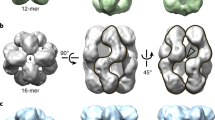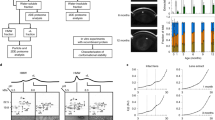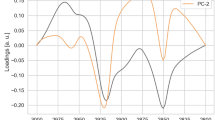Abstract
WITH ageing, a number of significant changes occur in the chemistry of the human lens. In the central region of the organ there is a slow transformation of protein to high molecular weight (HMW) aggregates greater than 50 × 106 (refs 1 and 2). It has been suggested that the relatively high concentration of such protein species in older lenses may cause significant light scattering3,4 and may be a contributing factor in the development of senile cataract characterised by central sclerosis and opacification1. An age-dependent increase in the insoluble protein fraction has also been observed5–8 and recent experiments indicate that the HMW species is an intermediate in the formation of this material15. Marked changes in the polypeptide chains of human lens proteins probably largely attributable to post-translational transformation, have also been observed16.
This is a preview of subscription content, access via your institution
Access options
Subscribe to this journal
Receive 51 print issues and online access
$199.00 per year
only $3.90 per issue
Buy this article
- Purchase on Springer Link
- Instant access to full article PDF
Prices may be subject to local taxes which are calculated during checkout
Similar content being viewed by others
References
Spector, A., Li, S., and Sigelman, J., Invest. Ophthal., 13, 795–798 (1974).
Jedziniak, J. A., Kinoshita, J. H., Yates, E. M., and Benedek, G. B., Expl Eye Res., 20, 367–369 (1975).
Benedek, G. B., Appl. Optics, 10, 459–473 (1971).
Spector, A., Israel. J. med. Sci., 8, 1577–1581 (1972).
Mach, H., Klin. Montasbl. Augenheilk, 143, 689–710 (1963).
Clark, R., Zigman, S., and Lerman, S., Expl Eye Res., 8, 172–182 (1969).
Satoh, K., Expl Eye Res., 14, 53–57 (1972).
Spector, A., Roy, D., and Stauffer, J., Expl Eye Res., 21, 9–24 (1975).
Satoh, K., Bando, M., and Nakajima, A., Expl Eye Res., 16, 167–172 (1973).
Harvey, D. G., and Rosen, W. J., J. chem. Soc., 97–101 (1938).
Pon, N. G., Schnackerz, K. D., Blackburn, M. N., Chatterjee, G. C., and Noltmann, E. A., Biochemistry, 9, 1506–1514 (1970).
Tschesche, R., Jensson, H., and Rangachari, P. N., Chem. Ber., 91, 1732–1743 (1959).
Abramovitch, R. A., and Spenser, I. D., in Advances in Heterocyclic Chemistry, 3, (edit. by Katritzky, A. R.), 79–207 (Academic, New York, 1964).
Wannemacher, C. F., and Spector, A., Expl Eye Res., 7, 623–625 (1968).
Roy, D., and Spector, A., Expl Eye Res., 22, (in the press).
Roy, D., and Spector, A., Biochemistry (in the press).
Author information
Authors and Affiliations
Rights and permissions
About this article
Cite this article
DILLON, J., SPECTOR, A. & NAKANISHI, K. Identification of β carbolines isolated from fluorescent human lens proteins. Nature 259, 422–423 (1976). https://doi.org/10.1038/259422a0
Received:
Accepted:
Issue Date:
DOI: https://doi.org/10.1038/259422a0
This article is cited by
-
Profiling of residue-level photo-oxidative damage in peptides
Amino Acids (2010)
Comments
By submitting a comment you agree to abide by our Terms and Community Guidelines. If you find something abusive or that does not comply with our terms or guidelines please flag it as inappropriate.



